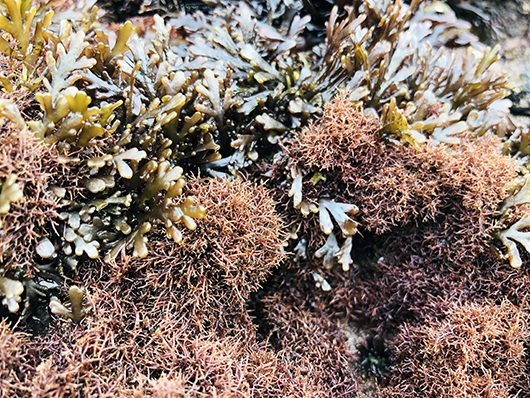Caulacathus okamurae Yamada

Other names: "Okamura's Pom-Pom Weed" (English).
Description: Densely tufted, dark purple to brownish, cartilaginous fronds, to 30 mm long, profusely and irregularly branched, often reflexed narrowing fairly abruptly towards the apices giving a horn-like appearance. Attached by creeping stolons producing multicellular rhizoids.
Habitat: On rock, on mussels and epiphytic, particularly on Osmundea and Fucus, intertidal, on wave-exposed shores.
Distribution: Adventive in the NE Atlantic (S Ireland, S and SW England, W Wales, NW France and NW Spain). Also Mediterranean France. Native Pacific populations widely distributed in China, Japan, and Korea. Potentially adventive populations in California and Washington State and in the Gulf of California.
Notes: Caulacanthus okamurae was first described from Japan and is known now to be native to Japan, China, Taiwan and Korea. It was reported from Brittany in 1986 where it spread widely in Brittany and ormandy; and was later found in S and SW Britain (Kent, Devon, Cornwall and Pemborkeshire) and Spain (Galicia). In Atlantic Spain it overlaps with a native species, Caulacanthus ustulatus, often occuring at the same level on the same shore. Initially in Atlantic France, the Netherlands and Britain, this seaweed was erroneously referred to as Caulacanthus ustulatus.

Photographs © M.D. Guiry. Curragh, Co. Waterford, Ireland; September 2020.





